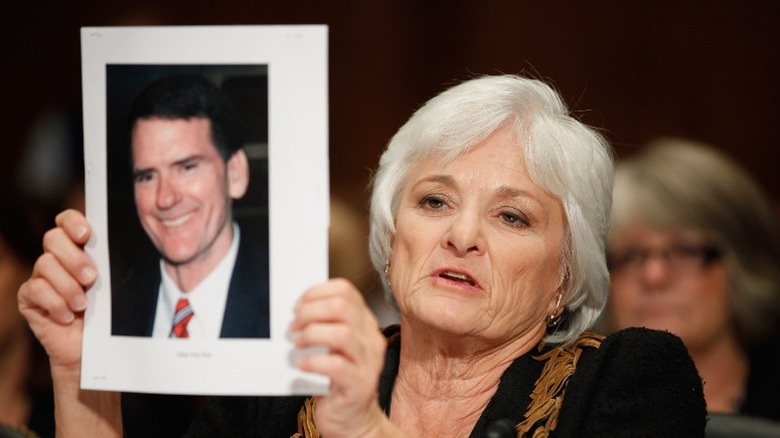Federal Judges Who Were Murdered Because Of Their Cases
The 2021 murder of federal judge Sandra Feuerstein made shocking headlines when the 75-year-old was struck down in a tragic hit-and-run accident while vacationing in Florida. The driver, 23-year-old Nastasia Snape, struck the judge when the car she was driving maneuvered off the road and onto the sidewalk where Feuerstein was walking. After striking Feuerstein, Snape is alleged to have struck another pedestrian, 6-year-old Anthony Ovchinnikov, who was seriously injured, according to ABC News.
Snape fled the scene, only to become involved in another crash minutes later. Unconscious when police responded to the scene, Snape's behavior became erratic and violent when she was placed in an ambulance. Claiming to be "Harry Potter," Snape was subdued by paramedics with medication so that she could be transported to a local hospital. Police found several containers of what they suspect to be THC in her vehicle, along with the designer drug known as "T Salts." As of this writing, Snape has been charged with vehicular homicide, leaving the scene of a crash involving death, and leaving the scene of a crash involving injury (per ABC 17 News).
Feuerstein was an appointed to the U.S. District Court of Eastern New York by President George W. Bush, who installed her on the bench in 2003. She and her mother, Judge Annette Elstein, have the distinction of being the first mother/daughter to serve in the role of judge at the same time. Feuerstein is one of six federal judges in the U.S. to have been murdered. But unlike the rest of those in this category, Feuerstein was the only one who was not an intentional target.
John P. Slough was assassinated by a member of the New Mexico Territorial Legislature
The first federal judge to be assassinated in the United States was John P. Slough. After being expelled from the bench in his native Ohio for punching a colleague, he ran an unsuccessful campaign to regain his position, narrowly losing to his opponent in a bitter recount vote. The Ohio Capital Journal reports that the defeated Slough packed up and moved westward, eventually settling in New Mexico. President Andrew Johnson appointed Slough to be the chief justice of the New Mexico Territorial Court, seeming to give the disgraced man a second chance.
It was in this state that Slough's temper would eventually lead to his death. After Slough assaulted a state official that he believed had overlooked him for ceremonious duties, a member of the territory's legislature, William Logan Rynerson, sponsored a resolution that declared Slough unfit for public office. In retaliation, Slough began a public campaign against Rynerson. According to the Ohio Capital Journal, he accused the lawmaker of being a "liar, a coward, and a thief."
Rynerson didn't take the news of the bad PR very well. He confronted Slough in a hotel bar, where he demanded that the judge take back the remarks. Slough steadfastly refused, leading to Rynerson pulling a Derringer from his pocket and shooting his adversary. Slough died the next day. Rynerson was tried for murder but acquitted a year later on grounds of self-defense (via True West Magazine).
John H. Wood Jr. was killed by a famous actor's father
Richard Nixon appointee John H Wood Jr. was gunned down in his driveway by a hired killer on May 29, 1979 (via Time). His assassination on that particular date was not without purpose, however. Wood, a U. S. District Judge, was to preside over the trial of accused narcotics dealer Jimmy Chagra. After being killed by a single shot from a high-powered rifle, Wood became the first sitting U.S. District Judge to be assassinated.
It was alleged that Chagra hired a hitman to do the job. According to the San Antonio Express-News, a $250,000 fee was paid to a man using the alias "Bill Bannister." The assassin completed the job, but the heat was soon on both the killer and the one who held the checkbook. Unable to escape his trial, Chagra was soon before another judge for the drug charges, eventually netting him almost four decades in prison. Ultimately, Chagra and his hired gunman were both charged with murder. While Chagra was ultimately acquitted, the man who went by the name Bannister was found guilty and convicted of murder. He was sentenced to two consecutive life terms plus five years, eventually dying in the federal supermax prison in Florence, Colorado (per the San Antonio Express-News).
An interesting footnote to this case was the identity of Bannister. His real name was Charles Harrelson, the father of actor Woody Harrelson.
Richard J. Daronco was murdered as revenge for his ruling in a civil lawsuit
Richard J. Daronco had only been appointed to the federal bench the year before his 1988 assassination by an angry ex-police officer. Daronco was shot at least three times by Charles L. Koster, who had become angered after the judge ruled against Koster's daughter in a civil suit she brought to the court. The Associated Press informs us that the shooter's daughter, Carolee Koster, filed a discrimination suit against her employer, Chase Manhattan Bank, in 1981. Koster and his wife had invested a lot of time and money in their daughter's case, which progressed slowly through the court over seven years and involved three separate judges. After turning down a large settlement from Chase, Carollee Koster was probably shocked when Daronco ruled in her ex-employer's favor in his March 1988 ruling.
Koster traveled upstate to Pelham, New York, where he shot and wounded Daronco, who was outside of his home. Though he had three bullets in him, Daronco managed to make it inside his home, where The Washington Examiner reports that he died. Daronco followed the judge into the house, then turned the gun on himself. He died of a single gunshot wound to the head. A note found in Koster's home was believed to have been written by the assailant. In the note, he expressed his disgust for the ruling against his daughter but insisted that the murder was an act he committed alone.
Robert Smith Vance was the victim of a mail bomb
A package delivered to the home of Fifth Circuit Appeals Court Judge Robert Smith Vance contained lethal contents. When Vance opened the box delivered to his door on December 16, 1989, the homemade bomb it contained exploded, killing him and seriously wounding his wife (via FBI).
Three similar bombs were mailed out, one exploding and killing Georgia attorney Robert Robertson. According to the FBI, investigators were able to identify the bomber from a case that they had successfully prosecuted nearly two decades before. An ATF bomb expert diffused one of the unexploded bombs and examined it, likening it to one he had seen years before that had been built by a man named Walter Leroy Moody. The bomb Moody constructed in the early 1970s had exploded and injured his wife. Moody was tried and convicted, angering him after he lost multiple appeals and creating resentment for the legal system.
In one of the largest investigations involving the FBI, Moody was apprehended and brought to trial on nearly 70 different charges. He was sentenced to death and executed in 2018.
John Roll was killed during a mass shooting
The assassination of U.S. District Court Judge John Roll occurred during a mass shooting committed by Jared Lee Loughner. Loughner was at a constituent meet-and-greet hosted by Arizona Congresswoman Gabrielle "Gabby" Giffords (via CNN). The man opened fire, severely wounding Gifford with a bullet to her head. A dozen others were wounded in the attack, which left six people dead.
Among the dead that day was Roll, who had earlier attended mass and decided at the last minute to spend some time at Giffords' event. CBS News reports that Roll was not believed to have been a target of Loughner. Sheriff Clarence Dupnik told the news outlet that Roll "was in the wrong place at the wrong time." For his crimes, Loughner faced the death penalty. In a plea agreement, he was able to avoid death row, however. U.S. District Judge Larry Burns sentenced Loughner to seven life terms, to be served consecutively. For added measure, Burns tacked on an additional 140 years.





